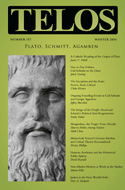David Randall’s “Humean Aesthetics and the Rhetorical Public Sphere” appears in Telos 157 (Winter 2011). Read the full version online at the TELOS Online website, or purchase a print copy of the issue here.
 This article aims to locate in the writings of David Hume the rhetorical aesthetics and philosophy of judgment that, under the name of “the conversable world,” constituted, in its essentials, the discursive, political, and moral project of Jürgen Habermas’s public sphere. Here the idea of the public sphere was shorn of the Kantian imperative to reason. Instead, Hume’s “conversable world” registered rhetorical assumptions—the key words reflecting the influence of rhetoric, and departing from Kantian strictures, were “disposition,” “pleasure,” and “best manner.” The existence of this Humean rhetorical aesthetics, as capable as Kant’s rationalizing aesthetics to claim itself as representative of the bourgeois public sphere, allows for the displacement of Kant’s aesthetics, in its historical aspect, from the conception of the public sphere. Humean rhetorical aesthetics, in turn, provide the essential historical component for the various ahistorical rhetorical critiques and revisions of Habermas’s public sphere theory, and of his philosophy writ large. It also allows for the formulation of what we may call a Humean public sphere. In contradistinction to the Kantian public sphere, the rhetorical philosophy of Hume associated the public sphere with a very different standard of judgment, a very different aesthetics, and a very different approach to teleology.
This article aims to locate in the writings of David Hume the rhetorical aesthetics and philosophy of judgment that, under the name of “the conversable world,” constituted, in its essentials, the discursive, political, and moral project of Jürgen Habermas’s public sphere. Here the idea of the public sphere was shorn of the Kantian imperative to reason. Instead, Hume’s “conversable world” registered rhetorical assumptions—the key words reflecting the influence of rhetoric, and departing from Kantian strictures, were “disposition,” “pleasure,” and “best manner.” The existence of this Humean rhetorical aesthetics, as capable as Kant’s rationalizing aesthetics to claim itself as representative of the bourgeois public sphere, allows for the displacement of Kant’s aesthetics, in its historical aspect, from the conception of the public sphere. Humean rhetorical aesthetics, in turn, provide the essential historical component for the various ahistorical rhetorical critiques and revisions of Habermas’s public sphere theory, and of his philosophy writ large. It also allows for the formulation of what we may call a Humean public sphere. In contradistinction to the Kantian public sphere, the rhetorical philosophy of Hume associated the public sphere with a very different standard of judgment, a very different aesthetics, and a very different approach to teleology.



